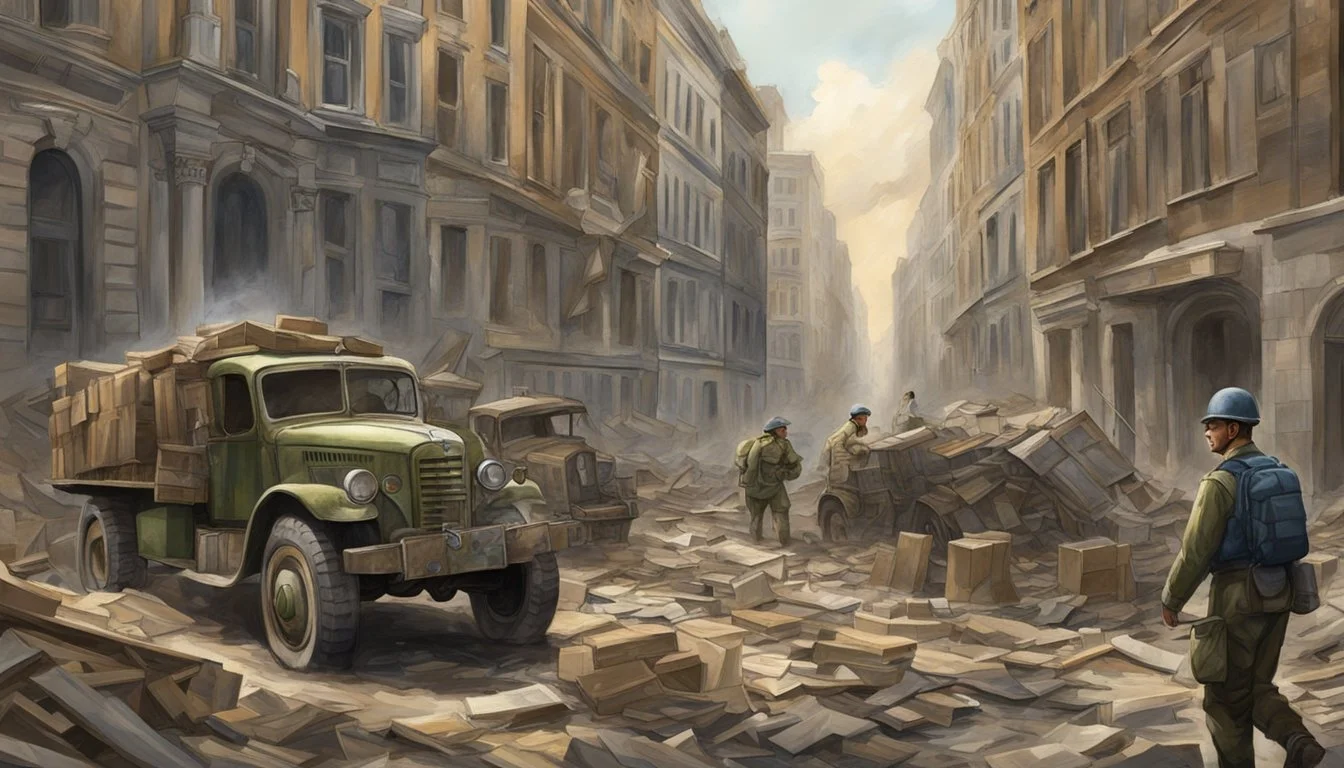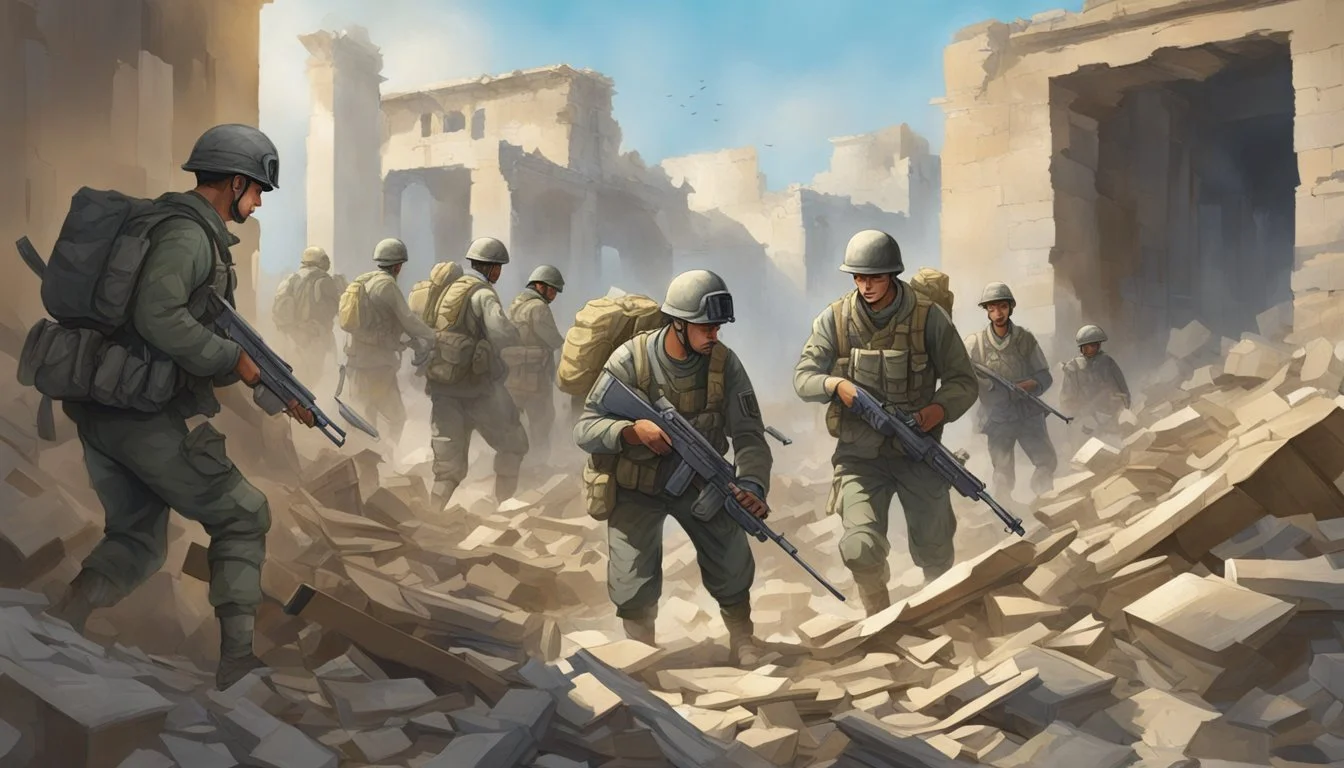Art in Wartime: The True Mission of 'The Monuments Men'
Saving Cultural Heritage During WWII
During World War II, a group of unlikely heroes emerged to protect Europe's cultural heritage from destruction and looting. The Monuments, Fine Arts, and Archives program, known as "The Monuments Men," consisted of art historians, curators, and museum professionals who risked their lives to rescue priceless artworks and artifacts. These brave individuals recovered millions of cultural treasures stolen by the Nazis, preserving them for future generations.
The story of the Monuments Men gained widespread attention in 2014 with the release of a Hollywood film directed by and starring George Clooney. While the movie took some creative liberties, it brought this remarkable true story to a global audience. The real Monuments Men faced incredible challenges as they raced against time to locate and safeguard artworks hidden in mines, castles, and other secret locations across Europe.
Art in wartime often becomes a target for destruction or theft, making the efforts of the Monuments Men even more crucial. Their mission extended beyond simply recovering stolen paintings and sculptures; it encompassed protecting buildings, monuments, and entire cities from the ravages of war. The legacy of the Monuments Men continues to inspire efforts to preserve cultural heritage in conflict zones around the world.
Historical Context of 'The Monuments Men'
World War II brought unprecedented destruction and looting of cultural artifacts across Europe. Nazi Germany's systematic theft of artworks and Hitler's grandiose plans for a museum complex intersected with Allied efforts to protect and recover cultural treasures.
World War II and Art Looting
The Nazi regime orchestrated a massive campaign of art theft during World War II. They plundered museums, galleries, and private collections across occupied Europe. Thousands of paintings, sculptures, and other cultural artifacts were seized and transported to Germany.
This systematic looting aimed to enrich the Third Reich and erase the cultural heritage of conquered nations. Jewish collectors were particularly targeted, with their art collections confiscated as part of the broader Nazi persecution.
The scale of art theft was staggering. Millions of items were displaced, hidden, or destroyed during the conflict. This cultural catastrophe threatened to erase centuries of artistic achievement and heritage.
Hitler's Vision and the Planned Führermuseum
Adolf Hitler, a failed artist himself, envisioned creating the world's greatest art museum in Linz, Austria. This planned Führermuseum was to be the centerpiece of a cultural complex showcasing "Aryan" art and looted masterpieces.
Hitler personally selected many artworks for this project. He compiled a list of desired pieces, which guided Nazi art theft operations across Europe. The Führermuseum was intended to elevate Linz to a cultural capital rivaling Vienna and Berlin.
Construction began in 1939, but the museum was never completed. The project's ambition reflected Hitler's megalomaniacal vision and the Nazi regime's broader cultural aims.
The Foundation of the Monuments, Fine Arts, and Archives Program
In response to the widespread destruction and looting of cultural heritage, the Allies established the Monuments, Fine Arts, and Archives (MFAA) program in 1943. This initiative aimed to protect cultural sites and recover stolen art.
The MFAA recruited art experts, historians, and museum professionals. These "Monuments Men" worked to:
Identify and protect important cultural sites
Track and recover looted artworks
Preserve damaged artifacts and buildings
Operating with limited resources, MFAA personnel faced significant challenges. They raced against time to locate hidden caches of stolen art before they could be destroyed or lost forever.
The efforts of the Monuments Men were crucial in safeguarding and recovering countless irreplaceable cultural treasures during and after World War II.
The Real Monuments Men
The Monuments, Fine Arts, and Archives (MFAA) program consisted of dedicated individuals who risked their lives to protect and recover cultural treasures during World War II. These experts came from diverse backgrounds in art history, architecture, and museum curation.
Key Figures in the Historical MFAA
George Stout, a conservator and museum director, played a crucial role in establishing the Monuments Men. His expertise in art preservation made him an invaluable asset to the team.
James Rorimer, a curator at the Metropolitan Museum of Art, worked tirelessly to track down looted artworks. His efforts were instrumental in recovering numerous masterpieces.
Rose Valland, a French art historian, secretly recorded Nazi art thefts while working at the Jeu de Paume Museum in Paris. Her information proved vital to the Monuments Men's mission.
Individual Contributions and Personal Stories
Frank Stokes, portrayed by George Clooney in the film adaptation, led the MFAA team. He coordinated efforts to locate and recover stolen art across Europe.
Robert M. Edsel, though not a member of the original Monuments Men, has been crucial in preserving their legacy. His research and books have brought their story to a wider audience.
The Monuments Men faced numerous challenges, including dangerous combat zones and Nazi booby traps. Despite these risks, they successfully recovered millions of cultural artifacts.
Their efforts extended beyond paintings and sculptures. They also protected architectural landmarks, archives, and other historically significant sites from wartime destruction.
The Mission to Recover Stolen Art
The Monuments Men embarked on a daring quest to reclaim priceless artworks looted by the Nazis during World War II. Their mission involved extensive searches, overcoming numerous challenges, and achieving remarkable recoveries.
Searching and Finding the Lost Art
The Monuments Men scoured Europe for hidden Nazi art repositories. They followed leads from local informants and captured documents. Salt mines became a focal point of their search efforts. The Altaussee salt mine in Austria emerged as a significant location, housing thousands of stolen masterpieces.
Art experts and curators among the Monuments Men used their specialized knowledge to identify authentic works. They meticulously cataloged each discovery, documenting the condition and provenance of recovered pieces.
Challenges in the Journey of Art Recovery
The team faced numerous obstacles in their mission. Time pressures were immense, with fears that retreating Nazi forces might destroy artworks. Dangerous conditions in war-torn areas posed constant risks.
Language barriers and limited resources hampered their efforts. The sheer volume of stolen art overwhelmed the small team. They often lacked proper equipment for safely transporting delicate pieces.
Nazi attempts to conceal or destroy evidence complicated the search. Some local populations were reluctant to cooperate, fearing reprisals or hoping to keep valuable works.
Significant Recoveries and Restitutions
The Monuments Men recovered millions of cultural items. Notable finds included Michelangelo's "Madonna of Bruges" and Jan van Eyck's "Ghent Altarpiece." They rescued paintings by masters like Rembrandt, Vermeer, and da Vinci from potential destruction.
In the Altaussee mine alone, they saved over 6,500 paintings. The recovery of the German national treasures from Bernterode mine was another major success.
Restitution efforts began immediately. The team worked to return artworks to their rightful owners or countries of origin. This process continued long after the war, with some cases remaining unresolved to this day.
Impact on Art and Culture
The Monuments Men left an indelible mark on the preservation of artistic and cultural heritage during World War II. Their efforts safeguarded countless masterpieces and shaped modern approaches to protecting cultural property in times of conflict.
The Protection of Cultural Property
The Monuments Men established groundbreaking protocols for safeguarding art and cultural artifacts during wartime. They created detailed maps and inventories of important cultural sites, allowing Allied forces to avoid damaging them during military operations.
This innovative approach helped preserve numerous historic buildings, monuments, and artworks across Europe. Notable examples include the protection of Leonardo da Vinci's "Last Supper" in Milan and the rescue of Michelangelo's "Bruges Madonna" from a salt mine in Austria.
Their work laid the foundation for international laws and agreements on protecting cultural property during armed conflicts, such as the 1954 Hague Convention.
Contributions to Art Conservation
The Monuments Men pioneered new techniques in art conservation and restoration under challenging wartime conditions. They developed methods for safely transporting fragile artworks and protecting them from environmental damage in temporary storage facilities.
Their expertise proved crucial in assessing and treating artworks that had suffered damage or neglect during the war. The team's efforts to catalog and document rescued artifacts set new standards for museum practices.
These innovations in conservation science and methodology continue to influence the field today. Many techniques first developed by the Monuments Men are still used by conservators to preserve and restore valuable cultural artifacts around the world.
Adaptation of History to Cinema
The story of the Monuments Men has been adapted for the big screen, blending historical events with cinematic storytelling. This adaptation process highlights the challenges of balancing factual accuracy with entertainment value.
Comparison with the 2014 Film
George Clooney directed and starred in the 2014 film "The Monuments Men" alongside Matt Damon, John Goodman, and Cate Blanchett. The movie portrayed the group's mission to save art from Nazi theft during World War II.
It condensed the real-life team of over 300 individuals into a small ensemble cast. This decision allowed for more character development but simplified the scope of the actual operation.
The film took creative liberties with timelines and specific events to create a more cohesive narrative. It incorporated elements of action and comedy to appeal to a broader audience.
Influence of Hollywood on Public Perception
Hollywood's adaptation brought widespread attention to the Monuments Men's story. The star-studded cast, including Bill Murray and Jean Dujardin, helped attract viewers who might not typically watch historical dramas.
The film's portrayal shaped public perception of the Monuments Men's mission. It emphasized the heroic aspects of their work and the high stakes involved in preserving cultural heritage.
Critics noted that the movie's lighter tone and focus on adventure elements may have downplayed the serious nature of the team's work and the wartime context.
Factual Accuracy vs. Artistic License
The filmmakers faced the challenge of balancing historical accuracy with cinematic storytelling. They maintained the core mission and key events while altering details for dramatic effect.
Some changes included:
Fictional character composites based on real Monuments Men
Dramatized action sequences
Simplified timelines of art recovery efforts
These alterations sparked discussions about the responsibility of historical films to adhere to facts. Historians praised the movie for raising awareness but criticized certain inaccuracies.
The film's reception highlighted the ongoing debate about the role of artistic license in portraying true stories on screen.
Legacy and Continued Relevance
The Monuments Men's impact extends far beyond World War II. Their efforts to protect cultural heritage continue to inspire preservation initiatives and shape policies today.
The Monuments Men Foundation
The Monuments Men Foundation honors the legacy of these art protectors. Established in 2007, it works to preserve their stories and continue their mission.
The foundation identifies and returns lost artworks to rightful owners. It also educates the public about the Monuments Men's achievements through exhibitions and publications.
Notable successes include the return of the Ghent Altarpiece panel in 2013 and the discovery of Hitler's photo albums in 2019.
Ongoing Restitution Efforts
Restitution of Nazi-looted art remains an active pursuit. Many museums and governments collaborate to identify and return stolen artifacts.
The Washington Principles, established in 1998, provide guidelines for addressing Nazi-confiscated art. These principles have led to the return of thousands of artworks to rightful heirs.
Recent high-profile cases include the 2021 restitution of Camille Pissarro's "La Cueillette des Pois" to the heirs of Simon Bauer.
Education and Remembrance
Museums and educational institutions play a crucial role in preserving the Monuments Men's legacy. They organize exhibitions, lectures, and workshops to raise awareness about cultural preservation during wartime.
The National WWII Museum in New Orleans features a permanent exhibit on the Monuments Men. It showcases their tools, uniforms, and personal effects.
Universities offer courses on art restitution and cultural property protection. These programs train future professionals in the field of cultural heritage preservation.
Digital archives, like the Monuments Men Foundation's database, make historical documents and photographs accessible to researchers and the public.



